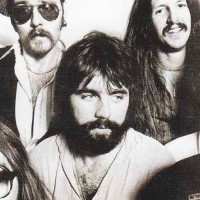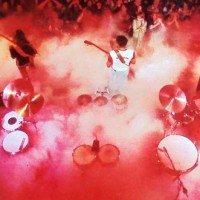News that the rejuvenated Doobie Brothers would be joining Chicago on a summer tour sent us scurrying back to the stacks.
And not just the Tom Johnston stuff, though his reunion with the band has sparked a third-act resurgence for the Doobies — one that included a return-to-form studio project back in 2010. We also gave a tip of the hat to second vocalist Michael McDonald, who moved the band into a smooth-as-glass hitmaking period by the end of the 1970s.
So, pretty mama, take us by the hand …
“JESUS IS JUST ALRIGHT” (TOULOUSE STREET, 1972) A deep cut from one of the most popular rock bands of the 1960s becomes a launching pad for one of the most popular rock bands of the 1970s. “Jesus Is Just Alright” (originally recorded by The Art Reynolds Singers, not the Byrds) was likely to draw the Doobies comparisons to the Allmans more so than the Byrds with its two percussionists, two guitarists both with a strong presence, and the jazzy interlude sung by Patrick Simmons interspersed with an acid-toned guitar lead. Such things were and still are hallmarks of the Allmans.
But there’s one thing on this song that early on had already set the Doobies apart: the Tom Johnston Shuffle. You know what I mean, it’s that same rhythm guitar you hear on “China Grove”, “Long Train Runnin'” and “Rockin’ Down The Highway,” which was incidentally on the flip side of the “Jesus” single.
A song originally written for testifyin’ ends up becoming a testament to the lasting appeal of one of the more consistently appealing mainstream rock bands of the decade. Praise be Tom Johnston and his shuffle! — S. Victor Aaron
“IT KEEPS YOU RUNNIN'” (TAKIN’ IT TO THE STREET, 1976): After leader Tom Johnston was forced off the road due to bleeding ulcers, the Doobie Brothers found themselves at a crossroads in 1975. They needed to fill the large gap Johnston left in order to record their next album. Guitarist Jeff “Skunk” Baxter, who had previously performed with Steely Dan, suggested a fellow Dan alum to join the band: keyboardist and vocalist Michael McDonald. This change began what could be termed Doobie Brothers Mach 2, when their music shifted from harder, sometimes country-tinged rock to a softer, urban-leaning sound. Their 1976 album Takin’ It to the Streets signaled the arrival of the new Doobie Brothers, and the single “It Keeps You Runnin’” exemplifies McDonald’s trademark R&B touch.
While the title track may receive more radio airplay today, “It Keeps You Runnin’” fascinates due to its jazz-kissed chord changes, slight tempo fluctuations, and a dead-on, blue-eyed soul vocal by McDonald. Rhythmic keyboards immediately introduce the track, along with a subtle, mid-tempo drum beat. Add McDonald’s soulful voice crooning that opening line, “Say, where you gonna go/ Girl, where you gonna hide,” and the listener is instantly hooked. When the tempo slightly increases, the drums kick in a bit harder, as does the bass. “You ain’t got no worry/ You just been lonely too long,” McDonald sings in an almost falsetto voice. The song then changes yet again, adding some jazzy chords and a slower beat to accompany the lines “I know what it means to hide your heart/ From a long time ago.” By the time the chorus arrives, the song has taken on a strident tone, emphasizing the title phrase.
Toward the end, “It Keeps You Runnin’” begins fading out over a tasty McDonald keyboard solo. Somewhere a version including a full solo must exist, and perhaps it will surface someday. Nevertheless, the song peaked at number 37 on the Billboard charts in early 1977, helping to propel Taking It to the Streets to number eight on the Billboard 200 chart. Indeed, “It Keeps You Runnin’” proudly announced the arrival of an artist who deftly combined R&B and rock to create accessible yet sophisticated songs. The classic track also heralded the arrival of Doobie Brothers 2.0, which proved to be an even more successful phase than Version 1.0. — Kit O’Toole
“I CHEAT THE HANGMAN” (STAMPEDE, 1975): This is a really weird song — actually, make that more like two songs — and it doesn’t sound a thing like the Doobie Brothers. In fact, if you close your eyes for a minute during the song’s first half, you could almost swear it was a leftover Stephen Stills track from a Crosby, Stills & Nash record. The harmonies, as well as the mellow, acoustic vibe mirror CSN to a tee. But that’s when things start to get weird. First the strings start to creep in, and by about the four minute mark, the song is nearly buried in them. Then, the whole thing shifts gears quite abruptly, and turns into a sonic Pink Floydian, space-rock freakout of guitars, strings, horns, crazy drums, and even more strings that swirl about your speakers right up to the final fade. Who knew the Doobs could be this avant-garde?
I was never the biggest Doobies fan. But by the time I first heard this (not knowing who the artist was), it was too late to take back the fact that I really liked it, mainly because it was just so damn different. Recorded for the underrated Stampede album, this is a great snapshot of the Doobie Brothers beginning the division shift from their past as a band of badass biker boys, into their latter-day incarnation as full-on middle of the roaders with Micheal McDonald on albums like Takin’ It To The Streets and Minute By Minute. — Glen Boyd
“WHAT A FOOL BELIEVES” (MINUTE BY MINUTE, 1978): Changing lead singers has been met with varying degrees of success (and failure) by different bands. Generally, those who are most successful are those who choose a completely different style of singer than that which they are replacing. That was the formula that the Doobie Brothers went with in choosing Michael McDonald to replace Tom Johnston.
Knowing that Tom Johnston was one of a kind, they opted to change their style to fit their new lead singer. It paid off in spades with What a Fool Believes. Many might disagree, but to me this song sounds like Earth Wind and Fire-meets-Steely Dan-meets-the Doobie Brothers. The background vocals are very reminiscent of EW&F’s vocal charts on songs like “Septemeber” and there’s decidedly more polish on the band under McDonald than there was under Johnston — trading in a gritty roadhouse boogie for a slightly more polished jazz-rock tinged Steely Dan-esque feel– but they still remained true to the Doobie Brothers sound despite the changes.
“What a Fool Believes” is perhaps one of the best, if not THE best example of how to replace a band’s lead singer the right way. This is what happens when all the pieces fall into place just right. — Perplexio, from DancingAboutArchitecture and The Review Revue
“WITHOUT YOU” (THE CAPTAIN AND ME, 1973): The big hits on this were “Long Train Runnin'” and “China Grove.” And sure enough, it’s tough to beat the latter for pure, reverb-drenched 1970’s guitar fun. So while it’s a deep cut on this album, “Without You” still brings the guitar power with it’s giant, overdriven shuffle opening. The verses drive up the energy with guitar playing in unison with the initial vocal lines.
A single chord splinters into feedback at the end of the bridge before the whole band explodes back to life. It’s so much fun.
Now that I think about it, this is the kind of song that Dave Marsh would dump on as being “boogie rock.” That’s OK, since Marsh strikes me as the kind of guy who “grew up” and forgot how to have fun in the process. Me? I’m still a dumb kid sometimes. — Mark Saleski
[amazon_enhanced asin=”B000002KE9″ container=”” container_class=”” price=”All” background_color=”FFFFFF” link_color=”000000″ text_color=”0000FF” /] [amazon_enhanced asin=”B000002KER” container=”” container_class=”” price=”All” background_color=”FFFFFF” link_color=”000000″ text_color=”0000FF” /] [amazon_enhanced asin=”B000002KFO” container=”” container_class=”” price=”All” background_color=”FFFFFF” link_color=”000000″ text_color=”0000FF” /] [amazon_enhanced asin=”B001CBW13U” container=”” container_class=”” price=”All” background_color=”FFFFFF” link_color=”000000″ text_color=”0000FF” /] [amazon_enhanced asin=”B002FUBW32″ container=”” container_class=”” price=”All” background_color=”FFFFFF” link_color=”000000″ text_color=”0000FF” /]
Here are the announced dates for Chicago and the Doobie Brothers:
July 11: Tucson, AZ, Anselmo Valencia Amphitheatre
July 13: Lake Tahoe, CA, Harvey’s Lake Tahoe
July 14: Concord, CA, Sleep Train Pavilion at Concord
July 15: Los Angeles, CA, Gibson Amphitheatre
July 17: Denver, CO, Red Rocks Amphitheatre
July 20: Kansas City, MO, Starlight Theatre
July 21: Dallas, TX, Gexa Energy Pavilion
July 22: Houston, TX, Cynthia Woods Mitchell Pavilion
July 24: Atlanta, GA, Chastain Park Amphitheatre
July 26: Raleigh, NC, Time Warner Cable Music Pavilion at Walnut Creek
July 29: Cincinnati, OH, Riverbend Music Center
August 1: Detroit, MI, DTE Energy Music Theatre
August 2: Pittsburgh, PA, First Niagara Pavilion
August 4: Atlantic City, NJ, Borgata Resort Spa & Casino
August 16: Boston, MA, Comcast Center
August 18: Wantagh, NY, Nikon at Jones Beach Theater
August 19: Holmdel, NJ, P.N.C. Bank Arts Center
August 21: Saratoga Springs, NY, Saratoga Performing Arts Center
August 23: Virginia Beach, VA, Farm Bureau Live at Virginia Beach
August 24: Scranton, PA, Toyota Pavilion
- Angell & Crane, “Himalayan Dial-Up” from ‘Angell & Crane’ (2024): Video Premiere - November 22, 2024
- Michael Attias, “Avrils” from ‘Quartet Music Vol. II- Kardamon Fall’ (2024): Streaming premiere - October 11, 2024
- Bryn Roberts, “Aloft” from ‘Aloft’ (2024): Video Premiere - September 20, 2024




Rejuvenated? That’s a good one. Reunion? Even better. The Doobie Brothers re-formed with the Tom Johnston/Pat Simmons nucleus in 1988 and have been touring with about 100 shows/year ever since, and 2 studio albums. Long time members Mike Hossack and John McFee are also with the band as well as 4-5 other FABULOUS musicians. The Doobie Brothers are better than ever.
2 studio albums since re-forming? I count four: “Cycles,” “Brotherhood,” “Sibling Rivalry” and from just couple of years ago, “World Gone Crazy.” But yes indeed, they have a great line-up today and are still performing at a high level.
So very right about Stampede being underrated. A shame the Brothers are not in the Rock and Roll Hall of Fame yet. Actually, with Chicago in tow, this could be the “Why aren’t they in the RRHOF” Tour? Both bands broke new ground in Rock and created a sound that fused Rock, Jazz, R and B, and Soul. Not to mention multiple lead singers and an ever evolving style that no matter which era you hear, each is distinctively recognized.